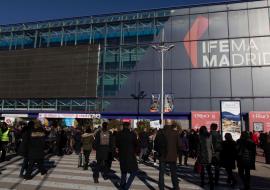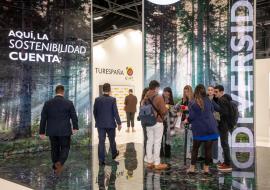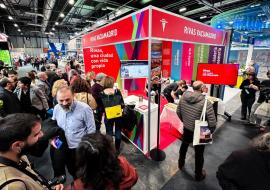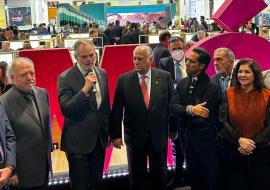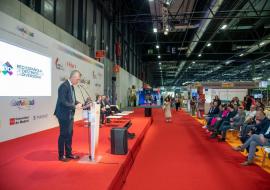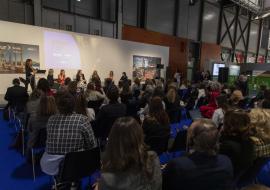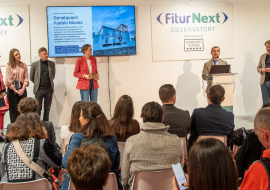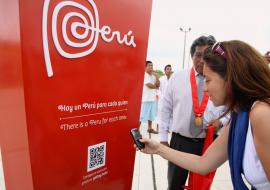Q & A with Ana Larrañaga, Director of FITUR
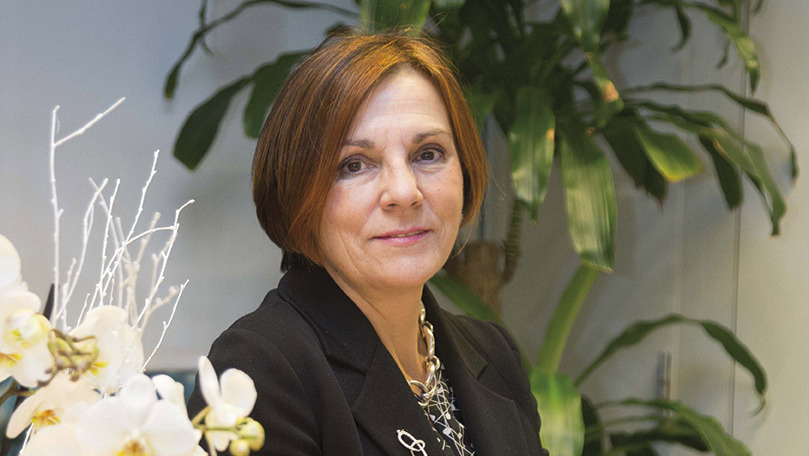
Ana Larrañaga is the successful director of FITUR, the outstanding International Tourism Fair of Madrid. On the expectations and new things this year’s edition has to offer, she sat down in an exclusive interview with Caribbean News Digital.
The first question mainly targets FITUR’s convening power for the Americas and the Caribbean, and the way we differentiate between both parties, the Americas and the Caribbean, as two sections within a pavilion. Why is it so successful and why does it happen in FITUR?
Ana Larrañaga: That question aims at the distinguishing characteristics of FITUR if compared to the most important local and international fairs taking place at the same time, mainly in Europe. FITUR stands out because of the presence of Latin American destinations, especially the Caribbean.
As you pointed out, there is a difference between the Americas and the Caribbean region of the Americas, with two blocks within them: the Spanish-speaking Caribbean and the non- Spanish-speaking Caribbean.
Why do the Americas and the Caribbean play a significant role in FITUR? There are obvious cultural and business reasons, which actually make a difference.
In terms of the travel industry, and the same happens with other sectors in Spain, the Spanish tourism companies have an outstanding presence throughout Hispanic-America, Latin America and the American Caribbean. Spain has signed bilateral business agreements with all of these countries, at different levels, depending on several variables. That is an important driving force and Spain is the first or second European outbound country to the Americas, for cultural and communication reasons.
The airlift is great. Iberia’s hub, between Madrid and the Americas, is the hub for the Latin American market, not only for Spanish travelers, but also for European and Asian tourists, who too come here and travel to America.
That is why Spain, specifically FITUR, is a strategic travel fair platform for those markets. As I previously detailed, the Caribbean is made up of the Hispanic Caribbean and the non-Hispanic Caribbean. There is an element that explains both realities: point-to-point airlift and bilateral business relations, which are far more intense, powerful and vigorous with the Spanish-speaking Caribbean. The level is lower with the English-speaking Caribbean because of its relation and history with the Anglo-Saxon world.
That reality is shown in FITUR, not only with the business presence, but also with politicians, because in the travel industry both the public and private sectors must have a close relation, beyond such connections as public-private, public-public or private-private. Those characteristics, that DNA or NID in the travel industry, shed importance on the presence of politicians, which is highly intense in FITUR. These are the reasons why FITUR is very interesting for this market.
Multi-destination travel has not been fostered within the framework of FITUR. How can FITUR be a driving force on this matter? What can FITUR do for tourism outbound countries to take Spain as a benchmark and sell their customers a two-three-day stop in Madrid, before traveling to America? What can FITUR do on this matter?
Ana Larrañaga: FITUR is a fair. Fairs put together international tourism offers and focus the attention on outstanding proposals and contents. How does FITUR define if they are outstanding or not? The sector does it.
FITUR provides exposure, highlights them and the message is sent. If the question refers to strengthening the hub in Madrid, the promoting organizations and tour operators attending the fair, as well as Iberia, have to work on Spain’s strength in FITUR, and they sure do.
There were economic reasons at the time, because we haven’t forgotten the crisis we lived and the fair has also reflected that situation, which has forced air carries make decisions. They have fortunately recovered their presence over the past two or three years, and they sure have strategies to strengthen everything.
They are the ones to attract the attention and develop their promotion, since once Madrid’s hub grows stronger, with unrivaled air and transportation services, the travel industry in Madrid would be boosted, not only to travel to other destination, but also to stay two or three nights here.
All advertising and communication tools must be used and FITUR is one of them. They are in FITUR, the interlocutors that have to organize and offer these services. That must be done with more intensity.
Could FITUR generate a congress or space devoted to that interrelation?
Ana Larrañaga: Yes, FITUR could do it or host that congress and highlight all these initiatives. FITUR is an inspiration platform. These things are there, but we don’t see them, they are not materialized or we don’t hear of them; however, they are to be taken into account.
In the Caribbean, as you were saying, we have the Spanish-speaking side and the non-Spanish-speaking. Within the Spanish-speaking segment, we are missing a country: Puerto Rico, and it will not be in FITUR this year.
Ana Larrañaga: We had it last year. San Juan de Puerto Rico was here. Puerto Rico actually came because Iberia’s line was opened.
You are right, San Juan came with an independent stand, but it is not here this year. Why would such classic country as Puerto Rico, which had a base for Europe, look for a space out of FITUR instead of in the fair?
Ana Larrañaga: That’s another smart question to ask them, Puerto Rico, but they do come to FITUR.
New countries are joining the fair this year and other nations are coming back, like Aruba, which had been away from FITUR. Within the framework of Cuba’s opening to the U.S. market, how do you think we could show the Caribbean nations that there is a European market to be boosted through Spain? Is there any proposal, any initiative to attract the Caribbean Tourism Organization to FITUR?
Ana Larrañaga: Yes, I think that the tourism traffic across the Caribbean region, with this new scenario, establishes a new image, since the U.S. flow will go to Cuba. This can be seen as a threat or an opportunity, and it can take tourists away from other destinations that were previously visited by U.S. travelers.
That transition in Cuba is also going to be an opportunity because there are many Spanish and European people traveling to the island nation. Therefore, it is not only about moving U.S. travelers, but also taking Spanish tourists to other islands.
I believe this is the perfect moment for all those destinations to value the potential of Spain as a tourist outbound country. By the way, in terms of expenses, the Spanish tourism segment has grown 17 percent between November 2015 and November 2016, and we have recorded 15 billion euros in expenses, thus surpassing the highest numbers obtained back in 2007, before the crisis.
Therefore, the potential is there. This option opens that connection. The non-Spanish-speaking Caribbean nations should make the most of it, they are already in FITUR and they are working on these options, since they require some time.
As for general matters related to FITUR, we are not talking about numbers, but about growth. FITUR has grown again this year. What region of the world is going to have the largest representation in FITUR?
Ana Larrañaga: Europe, Asia, Africa and America report a strong growth. The Near East remains just as it was last year.
Is there any new development?
Ana Larrañaga: Sustainability is FITUR’s motto this year. 2017 has just kicked off and the UN has declared it Year of Sustainable Tourism for Development.
Such matters as environmental, economic and social sustainability will be underlying in every project of FITUR, in those organized by FITUR with its collaborations and in destinations. Special attention will be paid to sustainability as a guideline in the future of the travel industry.
Several activities, debates, meetings, forums and awards will be tackling this matter. As new elements, we keep our sections and we are going to launch a new section for 2018. We are also set to introduce the new FITURTECH platform, a space made up of four areas: destinations, future, sustainability and everything related to innovation.
HEALTH will have its own exhibitors and sessions. We also have SEGITTUR, the space for startups that help optimize the travel industry.
B2B is the most effective business space, since it engulfs all of the agendas between exhibitors and buyers. The fair keeps on working to foster initiatives and platforms that help optimize contacts, so better businesses are signed.
Does any data or figure prove that this B2B help qualify the number of interviews that can be done in the different micro spaces within FITUR?
Ana Larrañaga: We had 2,000 interviews last year as a result of the scheduled B2B. In terms of B2B, we have always had meetings, but they weren’t scheduled. There is an agenda now and that makes the difference. The fair market has asked for it because we are walking out of a crisis, and that has brought about a change in business and priorities.
We are talking about a sector where personal and public relations play a leading role. We are talking about traveling, about two people with specific goals for that travel, leisure and pleasure services, where knowing customers is very important so they can be pleased. Therefore, the relational aspect is important, but the return of investment is a priority here, the contacts that facilitate and accelerate business agreements, etc.
In that ranking of priorities, the need to schedule and facilitate those meetings has become obvious and we are working on this matter. Besides their proactive activity, the exhibitors are going to have the opportunity to be in touch with the people that come from overseas. Having five days to develop these contacts is an undisputable opportunity in terms of cost-efficiency.
Does FITUR have or is it going to have a space on its website so the contacts can be materialized once the fair is over?
Ana Larrañaga:That platform, the professional meeting points (PEP is the Spanish acronym), does not offer that space because, once two people have met within the framework of the fair, the contact is between them. The platform can receive suggestions, improvements, but the contact is no longer held through that platform; it only facilitates and fosters meetings by means of previous planning.
Once people meet each other, everything they agree for their platform is directly managed by them. That’s the goal of B2B.
If that meeting does not take place, there is a space after the fair for those people to meet and keep in touch.
Ana Larrañaga: That’s right. That option can be given, but if I already have that contact, I won’t need a third person because that takes more times. The best way is to pick up the phone and call or send an email.
We have to be practical. Once you get a contact in the fair, you have to think about it, plan, organize the budget, etc., and then you have to get the documents you need, organize a meeting or a visit, if necessary.
Is Russia an outbound market for Spain? Is FITUR present in Russia?
Ana Larrañaga: We are presently not there. We have organized visits, but we haven’t held exhibits there, although we could assess that possibility. We are ready to enhance and retake initiatives that we previous issued, but couldn’t materialized due to the situation of the market there.
We still have our people there, working to identify buyers. Within the program of buyers, there is a group of Russians that have been identified by our people and have developed a tour operator and agency profile, at high level.
FITUR has always been a safe fair, surrounded by security. Is it going to be any different this year?
Ana Larrañaga: We are intensely working on the security aspect, but we don’t talk about it. That is a concern, nobody is exempt from things happening, but we are obviously working hard on that matter.







